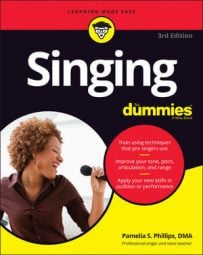The manner in which you take your bow after completing your singing performance depends on the concert. If you’re a famous diva, you may curtsy, but it’s better to wait on that until you arrive at one of the big opera houses. Until then, use the tried-and-true standard bow: Bend from the waist and bow your head to the audience.
After you find your spot on the stage, stop in place (with your feet close together) and lean forward from the waist. You want your head down, looking at the floor momentarily. Otherwise, it looks like you’re looking up to make sure that everyone is clapping.
Remember that you have to lean forward in your performance attire. If that’s a gown or tuxedo, make sure that it isn’t so tight that you can’t bend over at all or without revealing too much cleavage when you bow.
Your hands can be along the sides of your legs or clasped in front. Allow your hands to slide down your leg as you bend over. Remember not to put your hands in front of your zipper if you choose to clasp them.
Slowly count to two and raise your torso again. After you bow, acknowledge your accompanist. If the piece was a huge ensemble number, you may bow with your accompanist. You want to make that decision in advance and plan who bows when and after whom.
Some people like to turn and extend their arm to acknowledge the accompanist. If the pianist isn’t leaving the stage with you, that’s appropriate. But if you’re a team, plan bows separately and then together.
Exiting the stage is also an art. When you finish singing and take your bow, head toward the exit. Look at your audience again and smile as you exit the stage. If the audience just loved what they heard, they may continue clapping, so you can take another bow.
Wait for the peak of the applause and then go back onto the stage. If you had an accompanist playing for you, ask the accompanist to bow with you again or bow with you at the next curtain call.
Depending on the situation, you may want to prepare an encore. How will you know when to sing the encore? Finish your last number, hear the applause, and exit the stage; return to the stage for your bow and exit the stage again; and return to the stage and sing the encore, or return for another bow and then come back out to sing the encore.
An encore is appropriate for a recital where you are the main attraction or for a performance with a group such as a band or symphony. When you do more performing, you’ll figure out when an encore is appropriate and what to prepare for the encore.

